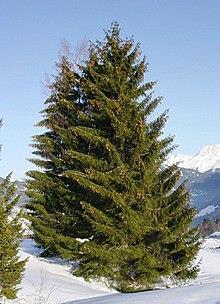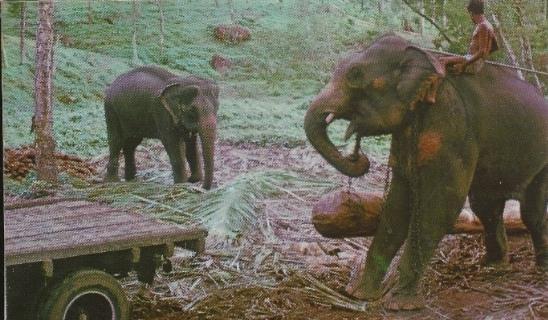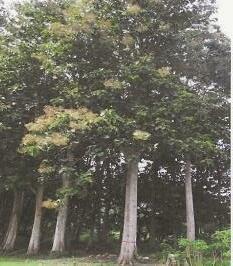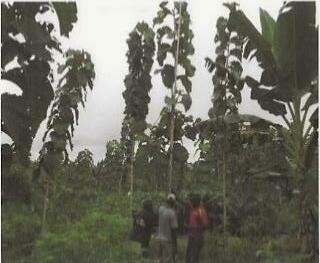
8 minute read
Development of Tropical Forest Tree Plantations
from PNGAF MAGAZINE ISSUE # 9D4D of 15th March 2022 - global timeline forest tree plantations
by rbmccarthy
Picea abies – Norway Spruce
Pinus sylvestris. – Scots pine or Baltic pine
Advertisement
Larix decidua European Larch Source Wikipedia.
A series of Acts of Parliament between 1698 and 1785 also encouraged tree planting in Ireland where large areas of Scots pine and European larch were planted by landlords in the eighteenth and early nineteenth centuries. From about 1809, enclosure and planting were increasingly adopted in the crown forests and oak (Quercus spp.) and subsequently Scots pine were planted. There was increasing interest in growing conifers for timbers, and this received a great stimulus form 1827 onwards when Douglas fir, Sikta spruce and other conifers were introduced from Western North America. In the latter part of the nineteenth century this major afforestation effort began to wane. Many reasons including other forms of investment made possible by the Industrial revolution and the growth of international commerce.
Clear cutting native forests followed by planting or artificial seeding became increasingly common in the middle of the eighteenth century, notably in parts of Germany and adjacent countries where German foresters were influential.
In Saxony there was widespread planting of Norway spruce (Picea abies) on sites formerly occupied by degraded hardwood or mixed hardwood-conifer forests. The first rotation grew fast but in places there was a serious decline in subsequent plantings in part due to problems with cycling of nutrients and organic matter.
The important lesson from the Saxony experience was the need to understand the biological processes of the plantation ecosystem as the basis for sustainable management. Prior to 1880, forestry practice in Germany and France had been developing and this played a crucial role in the development of forestry elsewhere in Europe, North America, and tropical countries as India.
Development of Tropical Forest Tree Plantations.
Turnbull described development of tropical plantations can be traced back to the sixteenth and seventeenth centuries with the expansion of European influence as colonial powers. From about 1600, the spread of European navies and colonizers from Portugal, Spain, holland, France and Britain around the globe encouraged exploitative timber export trade. The colonizers encouraged an exploitative timber export trade, often seriously damaging natural forests. Until the late 1800’s there was generally sufficient tropical natural forest and little need to plant trees for industrial wood production.
The scientific study of plants and animals led to systematic collections, botanical gardens flourished, and the domestication of several tropical tree species began (Turnbull, 2002). Plantation activities before 1900 included the introduction and testing of exotic species, especially teak and eucalypts, and the introduction of taungya and irrigated plantations. The establishment of government agencies, use of trained foresters and definition of forest policies and legislation provided an institutional framework on which the extensive forest plantations of the 20th century could be based.
There is a long history of planting teak in the tropics. In Asia there was extensive planting of teak for timber in Java under the control of the Sultans in the fifteenth century. (It may have started as early as the tenth century under Hindu influence).
With the arrival of the Portuguese in the fifteenth century and then the Dutch in the seventeenth century, the demand for durable teak timber for general construction and ship building intensified.
By 1784, the Dutch East India Company had acquired control of all teak forests and a monopoly on teak trading. The Company used a selective felling system, but when control was handed over to the Dutch Republic in 1800, selective felling was abolished, and clear felling followed by complete replanting was adopted. Under the influence of three German foresters, all the Javanese teak forests were brought under regular management in the late 1800’s.
The taungya regeneration method was introduced in 1873 and from 1985 almost all teak forests were regenerated by this system. Taungya is a system of forest plantations in which farmers plant the seeds or seedlings and tend the trees. As an incentive they are allowed to cultivate crops for the first few years between the seedlings of the plantation.
The term taungya originated in Myanmar and its application in government forestry is usually attributed to Dietrich Brandis, a forest officer in charge of Burmese teak forests from 1856 to 1862. In Myanmar, teak plantings began in 1856 and continued into the twentieth century. However, most plantations were damaged during World War 2. Planting was again started on a modest scale in 1963. It increased to more than 10,000 ha/yr. after 1984.
During the early 1800’s, teak was in short supply for ship building in India. In 1840, Conolly the Collector of Malabar, suggested teak should be planted - the first plantations were established in the Nilambur Hills (Puri, 1960). Between 1841 and 1855, some 600 ha were established and since 1840, this species has been planted both within and outside its area of natural occurrence. The taungya method was generally used to establish plantations in Karnataka, Kerala, Uttar Pradesh, West Bengal and most parts of Assam and Tamil Nadu, although many forests were naturally regenerated.
Teak was probably translocated outside its natural distribution range some 400 to 600 years ago, when it was naturalised in Java, Indonesia (Pandey and Brown10 2000) Verhaegen11 et al. 2010). Later plantations were established in Sri Lanka (Year 1680 Perera12 1962). In Africa, the Germans introduced teak to Tanzania at the end of the nineteenth century using seed from Calcutta, India (Madoffe and Maghembe13 1988). Later, before the First World War, many provenances of teak were introduced by the German colonial administration, with seed sources being from locations such as Tenasserim in southern Myanmar, Travancore in southern India and possibly also from Java (Wood14 1967).


Teak harvesting Sri Lanka. Photo credit Dick McCarthy member World Bank Forestry Appraisal Mission 1989.
In 1902, teak was planted for the first time in Nigeria, with seed first from India and subsequently from Myanmar or Thailand (Chollet15 1958; Horne16 1966). The species was introduced in Togo and Ghana in 1905 with seed from Nigeria (Chollet 1958) and in the Ivory Coast in 1926 with seed from Togo (Tariel17 1966).
In tropical America, the first pure teak plantations were started in 1913 in Trinidad and Tobago (Brooks18 1941). This was based on seed from Tenasserim in Myanmar (Beard19 1943, Keogh20 1978), and in the next 3 years, two additional seed lots were imported from the same source (Moore21 1966, Keogh 1978). This would later become known as the Tenasserim-Trinidad strain (Keogh 1978). Another important introduction in Central America was made in 1926 from Sri Lanka (at that time Ceylon) to Summit Gardens in Panama, where a rather small seed lot produced offspring that was later spread throughout the
10 D. Pandey and C. Brown, “Teak: A Global Overview,” Unasylva, Vol. 51, No. 201, 2000. pp. 3-12. 11 Verhaegen D, Jesus Fofana Inza, A. Z´enor Logossa, Daniel Ofori. What is the genetic origin of teak (Tectona grandis L.) introduced in Africa and in Indonesia? Tree Genetics & Genomes, Springer, 2010, 6, pp.717-733. <cirad-00846130. 12 Perera W.1962. The development of forest plantations in Ceylon since the 17th century. Ceylon Forester 5: 142–156. 13 Madoffe S. S., Maghembe J. A., 1988. Performance of teak (Tectona grandis L. f.) provenances seventeen years after planting at Longuza, Tanzania. Silv. Genet. 37, 5-6, 175-178. 14 WOOD P. J., 1967. Teak planting in Tanzania. In: Proceedings of the “World symposium on man-made forests and their industrial importance,” Canberra, Australia, 14-25 April 1967. FAO Section II silviculture, 1 631-1 643. 15 Chollet MA (1958) Le Teck au Togo. Bois For Trop 49:9–18. 16 Horne JEM (1966) Teak in Nigeria. Nigerian information bulletin (New Series) No. 16. 17 Tariel J (1966) Le Teck en Côte-d’Ivoire. Bois For Trop 107:27–47. 18 Brooks RL (1941) Notes on pure teak plantations in Trinidad. Caribb Forester 3(1):25–28. 19 Beard JS (1943) The importance of race in teak, Tectona grandis L. Caribb Forester 4(3):135–139. 20 Keogh RM (1978) Teak (Tectona grandis) provenances of the Caribbean; Central America; Venezuela and Colombia. Unpublished. Original document at FAO headquarters, Rome. 16 p. 21 Moore D (1966) The formation of teak plantations by the Group Planting System. Proceedings of the 6th World Forestry Congress, Vol. II, Madrid.
Panama Canal Zone and surrounding countries. This strain was named the Ceylon-Panama strain (Keogh 1978). Seed of these two above-mentioned strains was widely distributed in the region. A third significant strain, introduced into Honduras from Trinidad in 1927, probably originated in Myanmar, although not necessarily from the same place as the TenasserimTrinidad strain (Keogh 1978).
Most of the early introductions mentioned above were on a pilot basis, with large-scale planting only initiated more recently. However, the historical records presented above suggest that later upscaling of plantation forestry was often based on seed from the early introductions. The introduction and domestication history combined with the diverse environmental conditions present in the new teak growing areas could obviously have led to the formation of various landraces. This is supported by observations from international provenance trials where some landraces were found to deviate substantially in growth, stem form or early flowering from populations in the natural distribution area (Keiding22 et al. 1986). However, it has not been possible to test to what degree the landraces differ from their original source population because the genetic origin of the landraces has been uncertain or imprecisely described in almost all cases.


Teak planting Morobe Province PNG 23 . PNG original seed source was old German plantings prior 1914 Kokopo ENB. Source PNG FRI 2016
22 Keiding, H., Wellendorf, H., & Lauridsen, E. B. (1986). Evaluation of an International Series of Teak Provenance Trials. Forskningscentret for Skov & Landskab. Research and Documentation.
23Lata A (2016) Teak Plantations & Woodlots in PNG Teak Conference, LAO PDR 14-18th Nov 2016 PNG Forest Research Institute Anton Lata PNG Forest Authority Teak Domestication Manager alata@fri.pngfa.gov.pg Presentation.








